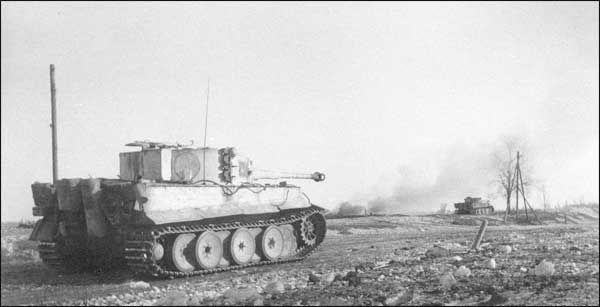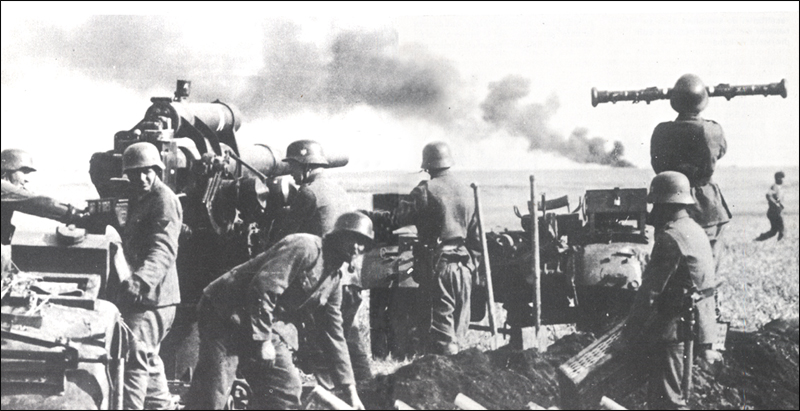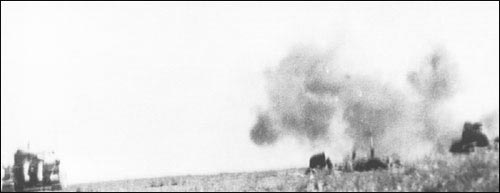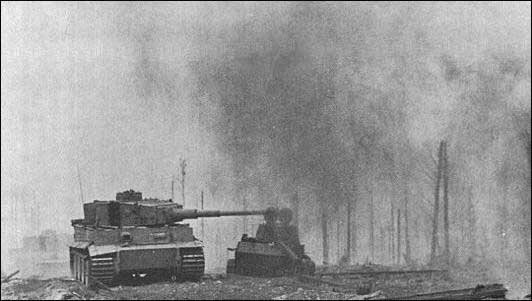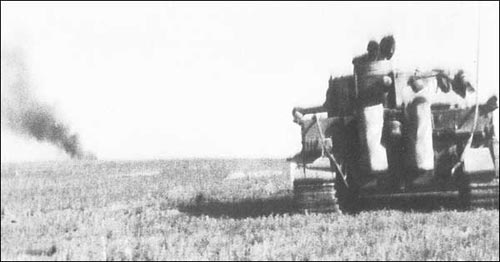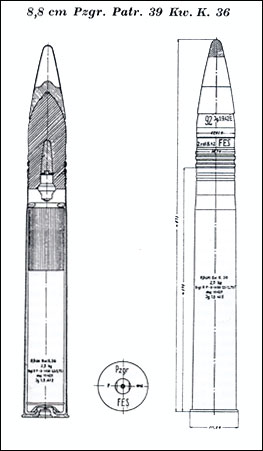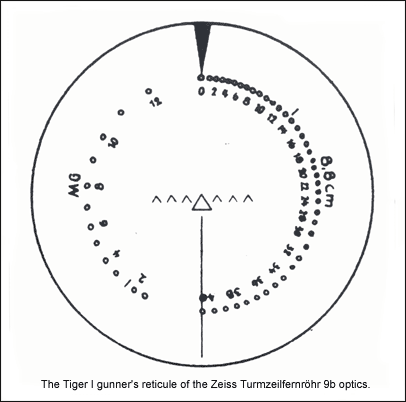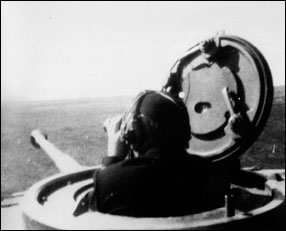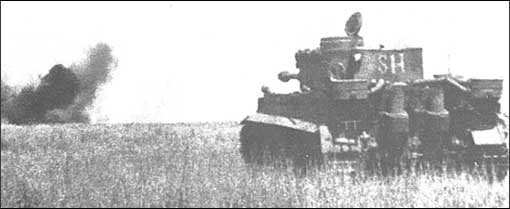 PzKpfw VI Tiger I, or SdKfz 181.
Firepower Introduction to the 88 mm KwK 36 L/56 gun. The 8.8 cm KwK 36 L/56 was an adaptation of the famous 8.8 cm Flak 36, which was a development of the Flugzeugabwehrkanone Model 18 (Flak 18), and was first used in combat by the Condor Legion, in Spain, where it earned the reputation of being an excellent anti-aircraft gun as well as a tank killer. This capacity would be confirmed during the French campaign in 1940, and most spectacularly in the hands of Rommel's Afrika Korps in North Africa. The Flak 36 was essentially a Flak 18 mounted in three sections, making possible to change the part of the barrel that suffered most attrition from the high-velocity rounds. By the time the Wehrmacht was heavily committed in Russia, it proved to be the only gun in the German inventory capable to destroy the new T-34 and KV-2 Russian tanks at longer ranges.
In 1938 the 8.8 cm Flak 18 was considered for firing against ground targets, specifically armored/concrete pillboxes and enclosures, and the armor piercing ammunition that would be in service from this time onwards consisted of the 8.8 cm Panzergranate weighing around 9.5 kg with armor piercing cap and ballistic cap with a high explosive filler of 160 grams. Muzzle velocity is listed as 810 m/s from the L/56 barrel of the Flak 18 and Flak 36/37. During early 1942 the penetration ability was improved with the introduction of the Pzgr.39 of 10.2 kg weight with reduced HE filler of 59 grams. Muzzle velocity was 800 m/s. The early Blitzkrieg up to early 1942 saw the use of the large capacity Pzgr. with penetration less than 100 mm at 30 degrees. The 88 mm Flak APCBC round which fought the KV and T34 tanks during 1941 and early 1942 was less effective than the round fired by the Tiger's 88 mm KwK 36 L/56. Even the later 88 mm Flak round with a large capacity high explosive filler (and 9.54 kg weight) penetrated from 8% to 23% less than the 88 mm KwK 36 L/56 APCBC round.
In May 1941 the German general staff had demanded a new Kampfwagen Kanone (Tank Gun) specification for the Tiger; it had to be capable of penetrating 100 mm at about 1,500 meters and the improved Pzgr.39 could approach that. This is one of the two reasons why the 88 mm KwK 36 L/56 was retained as the main gun of the Tiger I, instead of the Rheinmetall 75 mm KwK 42 L/70. The other reason was the fact that at that time, armor penetration was mainly a function of thickness to diameter (T/d) ratio. During World War II, the Armor Piercing (AP) round relied on its own weight (and a 88 mm KwK 36 L/56 gun APCBC shell weighed 10.2 Kilograms, as opposed by an 75 mm KwK 42 L/70 gun APCBC shell, which weighed 6.8 Kilograms) to penetrate the enemy's armor. Theoretically, the higher the muzzle velocity, the more penetration any kind of AP round would have, all other variables remaining constant. In real World War Two tank combat, however, other important variables intervened, such as the thickness to diameter (T/d) coefficient, which means that the higher the diameter of any given round relative to the thickness of the armor it is going to strike, the better the probability of achieving a penetration. Furthermore, if the diameter of the armor piercing round overmatches the thickness of the armor plate, the protection given by the inclination of the armor plate diminishes proportionally to the increase in the overmatch of the armor piercing round diameter or, in other words, to the increase in this T/d overmatch. So, when a Tiger hit a T-34, the 88 mm diameter of the Tiger's round overmatched the 45 mm glacis plate of the T-34 by so much that it made no difference that the Russian tank's glacis was inclined at an angle of 60 degrees from vertical. "Armor obliquity effects decrease as the shot diameter overmatches plate thickness in part because there is a smaller cylindrical surface area of the displaced slug of armor which can cling to the surrounding plate. If the volume which the shot displaces has lots of area to cling to the parent plate, it resists penetration better than if that same volume is spread out into a disc with relatively small area where it joins the undisturbed armor. Plate greatly overmatching shot involves the projectile digging its own tunnel, as it were, through the thick interior of the plate. It was found experimentally that the regions in the center of the plate produced the bulk of the resistance to penetration, while the outer regions, near front and rear surfaces, presented minimal resistance because they are unsupported. Thus, an overmatched plate will be forced to rely on tensile stresses within the displaced disc, and will tend to break out in front of the attacking projectile, regardless of whether the edges cling to the parent material or not. Plate obliquity works in defeating projectiles partly because it turns and deflects the projectile before it begins digging in. If there is insufficient material where the side of the nose contacts the plate, stresses will travel all the way through the plate and break out the unsupported back surface. The plate will fail instantaneously rather than gradually". "You can angle the armor any way you want, and beyond a certain point of shot overmatching plate, the obliquity will cease to be relevant. In fact, at certain conditions of shot overmatching plate, the cosine rule is broken and the plate resists less well than the simple cosine relationship would predict (LOS thickness is greater than effective thickness). The above only applies to WWII era AP and APC/APCBC, and WWII sub caliber ammunition. The long rod penetrators of today are greatly overmatched but they bring so much energy to the plate that they penetrate by "ablation" in which both projectile and armor behave like fluids. Hollow charge also enters the field of fluid dynamics, with a very thin jet penetrating overmatching armor with ease, regardless of obliquity" (Robert Livingston; excerpts of a response to a question posted on the old "Tanker's Forum (Heavy Metal Website)", back in 1998).
The 13.(Tiger) Kompanie, of Panzer Regiment Großdeutschland, reported on the performance of the 88 mm KwK 36 L/56, when their Tigers engaged the T-34: "First round hits were usually achieved at ranges between 800 to 1,000 meters. At these ranges, the Panzer Granate (they are referring to the PzGr. 39 APCBC ammunition) absolutely penetrated through the frontal armor, and usually still destroyed the engine at the rear of the T-34 tank. In 80 percent of the cases, shots from the same range hitting the side of the hull toward the rear of the tank resulted in the fuel tanks exploding. Even at ranges of 1,500 and longer, during favorable weather, it is possible to succeed in penetrating the T-34 with minimal expenditure of ammunition" (JENTZ, Thomas L.; Germany's TIGER Tanks - Tiger I and II: Combat Tactics; op. cit.). Many more reports like this one attest to the precedent arguments on the superior performance of the 88 mm KwK 36 L/56 gun.
Accuracy and Penetration Tables for the 8.8 cm KwK 36 L/56. The 8.8 cm KwK 36 L/56 was a very accurate gun capable of first round hits at over 1,000 meters - the Tiger I actually started first round killing at 1,200 meters, under combat conditions. Considering that the Tiger I was nearly impervious to penetration by most tank and anti-tank guns at normal combat ranges (+/- 800 meters), these were the two main assets (Firepower + Armor Protection) that made it possible for the Tiger I to virtually dominate the battlefield. The long and powerful 88 mm KwK 36 L/56 could outrange and outshoot nearly all Allied tanks, and this allowed the Tiger I to stand off and engage targets as it chose. On 21 July 1943, General der Panzertruppe Breith, commander of the III.Panzer - Korps, issued the following directive: "Based on experience in the recent battles, I issue the following instructions for the cooperation of Tigers with other weapons: As a result of its high performance weapon and strong armor, the Tiger should be used primarily against enemy tanks and anti-tank weapons and secondarily - and then only as a complete exception - against infantry units. As experience has shown, its weapons allow the Tiger to fight enemy tanks at ranges of 2,000 meters and longer, which has especially worked on the morale of the opponent. As a result of the strong armor, it is possible to close to short range with the enemy tanks without being seriously damaged by the hits. Still, the Tiger should attempt to start engaging enemy tanks at ranges over 1,000 meters". According to Jentz (JENTZ, Thomas L.; Germany's TIGER Tanks - Tiger I and II: Combat Tactics; op. cit.): "These accuracy tables are based on the assumptions that the actual range to the target has been correctly determined and that the distribution of hits is centered on the aiming point. The first column shows the accuracy obtained during controlled test firing to determine the pattern of dispersion. The figures in the second column include the variation expected during practice firing due to differences between guns, ammunition and gunners. These accuracy tables do not reflect the actual probability of hitting a target under battlefield conditions. Due to errors in estimating the range and many other factors, the probability of a first hit was much lower than shown in these tables. However, the average, calm gunner, after sensing the tracer from the firstround, could achieve the accuracy shown in the second column".
Please note that 88 mm KwK 36 L/56 means: The diameter of the bore (caliber) of this gun is 88 mm; this is a Tank Gun (Kampfwagenkanone); that the year the development of this gun was finalized was 1936; and that the length of the gun equals 56 times the diameter of the bore (caliber) of the same gun. This was the main gun installed on the Tiger I. Ammunition used with the 88mm KwK 36 L/56 gun.
As far as the Tiger I is concerned, the two main types of armor piercing ammunition were the APCBC and the APCR. The Armor Piercing Capped, Ballistic Capped (APCBC) round relied not only on its own weight to penetrate the enemy's armor, but was also filled with high explosive that caused great internal damage. The APCBC round has two caps covering the main body of the round. The first one is a cap designed for ballistic performance, and is a blunt cap, because a projectile with a blunt nose has less chance to ricochet off inclined armor. This is covered by the second cap, a sharp one, a "windshield" made of light metal, designed to give the round a better aerodynamic shape. The Armor Piercing Composite Rigid (APCR) round was made with a tungsten core. For flight performance effects and to aid the shot from shattering against armor plating, the APCR round was surrounded by a ballistic cap. The APCR rounds had a higher penetration capacity, but were less lethal than the APCBC after penetration, and also had a shorter effective range.
The Tiger I carried 92 rounds of ammunition, although it is known that experienced crews frequently broke the regulations, by storing more than that. The recommended and most usual mix was 50 percent APCBC (Pzgr.39) and 50 percent HE (Sprenggranaten - high explosive shells). A few rounds of the rare (due to the shortage of tungsten carbide) APCR (Pzgr.40) ammunition might be carried for use against the heaviest armored Russian tanks and tank destroyers. The Gr.39 HL (Hohlgranate) based on the hollow charge principle (HEAT), was less accurate and much less destructive than the APCBC rounds, but could be carried in place of the HE rounds and used either to combat armor or as effective high explosive ammunition against soft targets. The Tiger I optics, by Zeiss: The Turmzielfernröhr 9b.
The sights that equipped the Tiger I up to 1944 were the binocular Turmzielfernröhr 9b mounted parallel and on the same axis as the main gun (see this page for details on Tiger I gunnery).
The commander ordered the target selection, type of ammunition, and range. The gunner observed the tracer and the strike of the round and reported his observations to the commander, who then ordered corrections. To quickly traverse onto a target, the Tiger I was outfitted with a hydraulic motor for the turret drive. The hydraulic drive traversed the turret at a maximum rate of 360 degrees in 60 seconds, dependent on the engine speed. Placing the target on the point of a triangle allowed the gunner to aim without obstructing the view of the target. The triangle height and separation distances in mils were used as an aid in estimating the range to the target, by comparing them with the size of the target. Tiger gunners knew the size of their targets from target tables and later, by practice, instinctively knew distances. The pattern in the right reticule also contained the 7 triangles plus adjustable range scales that allowed the gunner to register the exact range to the target. The gunner adjusted the range through this sight by lowering or raising the gun to set the aiming sight again on target. The range scale was graduated at 100 meter intervals out to a range of 4,000 meters for the APCBC and APCR rounds, and up to 6,000 meters for the HE rounds.
The 88 mm KwK 36L/56 gun had a very high muzzle velocity and the shell traveled in a stretched arc, which gave the Tiger I more advantages than just penetration power. Besides providing a higher penetration power it also allowed a higher margin of error in range guessing, because the gunner could guess wrong up to 200 meters and still hit the target, since aiming too high simply raised the striking point by less than a meter, too little an error to miss a 3 meter high tank when aimed at its center. Under combat situations, judging from the Tiger units action reports, the most effective engagement range for the Tiger I was between 800 and 1,200 meters, and kills beyond 2,000 meters were considered lucky hits. From April, 1944 the new Tigers I were equipped with the monocular Turmzielfernröhr 9c. Tiger platoons could open fire (concentrated platoon fire) for effect against stationary targets at up to 3,000 meters. When firing against moving targets, the rule was to open fire starting at 1,200 meters and up to 2,000 meters. Every bit of information on www.fprado.com/armorsite is for the purpose of information, criticism, comment, news reporting, teaching, scholarship, and/or research. The ARMOR Site! is © Copyright 1997-2005 Fabio Prado . All Rights Reserved. |
|||||||||||||||||||||||||||||||||||||||||||||||||||||||||||||||||||||||||||||||||||||||||||||||||||||||||||||||||||||||
